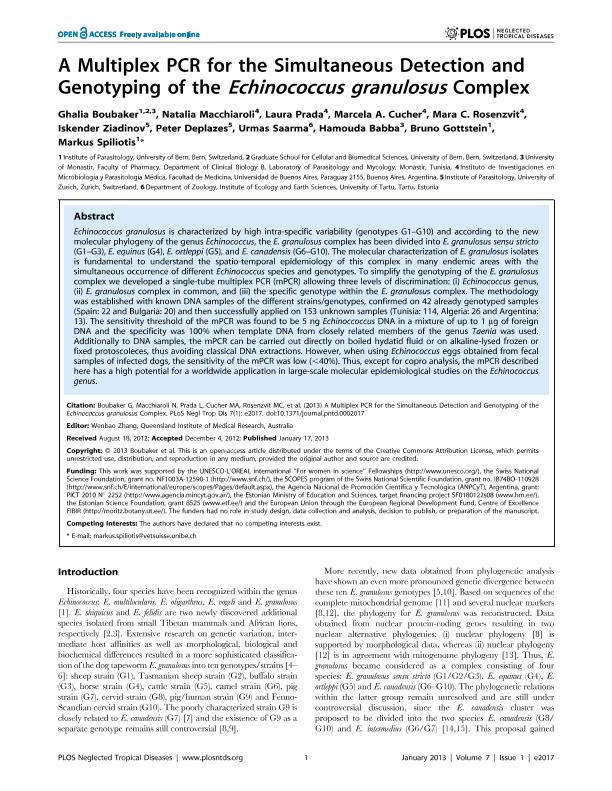Mostrar el registro sencillo del ítem
dc.contributor.author
Boubaker, Ghalia
dc.contributor.author
Macchiaroli, Natalia

dc.contributor.author
Prada, Laura Cecilia

dc.contributor.author
Fernández, Cecilia

dc.contributor.author
Rosenzvit, Mara Cecilia

dc.contributor.author
Ziadinov, Iskender
dc.contributor.author
Deplazes, Peter
dc.contributor.author
Saarma, Urmas
dc.contributor.author
Babba, Hamouda
dc.contributor.author
Gottstein, Bruno
dc.contributor.author
Spiliotis, Markus
dc.date.available
2017-07-26T17:42:39Z
dc.date.issued
2013-01
dc.identifier.citation
Boubaker, Ghalia; Macchiaroli, Natalia; Prada, Laura Cecilia; Fernández, Cecilia; Rosenzvit, Mara Cecilia; et al.; A multiplex PCR for the simultaneous detection and genotyping of the Echinococcus granulosus complex; Public Library of Science; Neglected Tropical Diseases; 7; 1; 1-2013; 1-13; e2017
dc.identifier.issn
1935-2735
dc.identifier.uri
http://hdl.handle.net/11336/21342
dc.description.abstract
Echinococcus granulosus is characterized by high intra-specific variability (genotypes G1–G10) and according to the new molecular phylogeny of the genus Echinococcus, the E. granulosus complex has been divided into E. granulosus sensu stricto (G1–G3), E. equinus (G4), E. ortleppi (G5), and E. canadensis (G6–G10). The molecular characterization of E. granulosus isolates is fundamental to understand the spatio-temporal epidemiology of this complex in many endemic areas with the simultaneous occurrence of different Echinococcus species and genotypes. To simplify the genotyping of the E. granulosus complex we developed a single-tube multiplex PCR (mPCR) allowing three levels of discrimination: (i) Echinococcus genus, (ii) E. granulosus complex in common, and (iii) the specific genotype within the E. granulosus complex. The methodology was established with known DNA samples of the different strains/genotypes, confirmed on 42 already genotyped samples (Spain: 22 and Bulgaria: 20) and then successfully applied on 153 unknown samples (Tunisia: 114, Algeria: 26 and Argentina: 13). The sensitivity threshold of the mPCR was found to be 5 ng Echinoccoccus DNA in a mixture of up to 1 µg of foreign DNA and the specificity was 100% when template DNA from closely related members of the genus Taenia was used. Additionally to DNA samples, the mPCR can be carried out directly on boiled hydatid fluid or on alkaline-lysed frozen or fixed protoscoleces, thus avoiding classical DNA extractions. However, when using Echinococcus eggs obtained from fecal samples of infected dogs, the sensitivity of the mPCR was low (<40%). Thus, except for copro analysis, the mPCR described here has a high potential for a worldwide application in large-scale molecular epidemiological studies on the Echinococcus genus.
dc.description.abstract
The dog tapeworm Echinococcus granulosus (E. granulosus) is a cosmopolitan parasite. The adult worms reside in the small intestine of their definitive hosts (dogs). Infective eggs are shed with the feces into the environment and are orally ingested by intermediate hosts where they develop into the metacestode (larval) stage, causing cystic echinococcosis (CE) in humans and livestock. Ten intraspecific genotypes of E. granulosus (G1 to G10) have been reported from different intermediate host species. Based on the recently established molecular phylogeny, E. granulosus is now considered a complex consisting of four species: E. granulosus sensu stricto (G1/G2/G3), E. equinus (G4), E. ortleppi (G5) and E. canadensis (G6–G10). Simple and highly discriminative molecular epidemiological approaches are needed to explore dynamics, life cycle patterns, and the pathogenicity of the members of this complex. We here introduce a one-step multiplex PCR (mPCR) protocol for the genotyping and discrimination of the different members of the E. granulosus complex, allowing three levels of discrimination: (i) Echinococcus genus, (ii) E. granulosus complex, and (iii) genetic variants within the E. granulosus complex. The relatively complicated task of E. granulosus complex speciation and genotyping is clearly simplified by mPCR, and this technique therefore represents a useful tool for routine practice. (Author Summary)
dc.format
application/pdf
dc.language.iso
eng
dc.publisher
Public Library of Science

dc.rights
info:eu-repo/semantics/openAccess
dc.rights.uri
https://creativecommons.org/licenses/by/2.5/ar/
dc.subject
One-Vial
dc.subject
Single-Tube
dc.subject
Multiplex
dc.subject
Pcr
dc.subject
Detection
dc.subject
Genotyping
dc.subject
Genotype
dc.subject
Cystic
dc.subject
Echinococcosis
dc.subject
Echinococcus
dc.subject
Granulosus
dc.subject
Sensu Stricto
dc.subject
Equinus
dc.subject
Ortleppi
dc.subject
Intermedius
dc.subject
Canadensis
dc.subject
Multilocularis
dc.subject
Echinococcus Genus
dc.subject
Granulosus Complex
dc.subject
Boiled
dc.subject
Hydatid Fluid
dc.subject
Alkaline-Lysis
dc.subject
Protoscoleces
dc.subject
Protoscolex
dc.subject.classification
Parasitología

dc.subject.classification
Ciencias de la Salud

dc.subject.classification
CIENCIAS MÉDICAS Y DE LA SALUD

dc.subject.classification
Bioquímica y Biología Molecular

dc.subject.classification
Ciencias Biológicas

dc.subject.classification
CIENCIAS NATURALES Y EXACTAS

dc.title
A multiplex PCR for the simultaneous detection and genotyping of the Echinococcus granulosus complex
dc.type
info:eu-repo/semantics/article
dc.type
info:ar-repo/semantics/artículo
dc.type
info:eu-repo/semantics/publishedVersion
dc.date.updated
2017-07-25T14:59:47Z
dc.journal.volume
7
dc.journal.number
1
dc.journal.pagination
1-13; e2017
dc.journal.pais
Estados Unidos

dc.journal.ciudad
San Francisco
dc.description.fil
Fil: Boubaker, Ghalia. University of Berne; Suiza
dc.description.fil
Fil: Macchiaroli, Natalia. Consejo Nacional de Investigaciones Científicas y Técnicas. Oficina de Coordinación Administrativa Houssay. Instituto de Investigaciones en Microbiología y Parasitología Médica. Universidad de Buenos Aires. Facultad de Medicina. Instituto de Investigaciones en Microbiología y Parasitología Médica; Argentina
dc.description.fil
Fil: Prada, Laura Cecilia. Consejo Nacional de Investigaciones Científicas y Técnicas. Oficina de Coordinación Administrativa Houssay. Instituto de Investigaciones en Microbiología y Parasitología Médica. Universidad de Buenos Aires. Facultad de Medicina. Instituto de Investigaciones en Microbiología y Parasitología Médica; Argentina
dc.description.fil
Fil: Fernández, Cecilia. Consejo Nacional de Investigaciones Científicas y Técnicas. Oficina de Coordinación Administrativa Houssay. Instituto de Investigaciones en Microbiología y Parasitología Médica. Universidad de Buenos Aires. Facultad de Medicina. Instituto de Investigaciones en Microbiología y Parasitología Médica; Argentina
dc.description.fil
Fil: Rosenzvit, Mara Cecilia. Consejo Nacional de Investigaciones Científicas y Técnicas. Oficina de Coordinación Administrativa Houssay. Instituto de Investigaciones en Microbiología y Parasitología Médica. Universidad de Buenos Aires. Facultad de Medicina. Instituto de Investigaciones en Microbiología y Parasitología Médica; Argentina
dc.description.fil
Fil: Ziadinov, Iskender. Universitat Zurich; Suiza
dc.description.fil
Fil: Deplazes, Peter. Universitat Zurich; Suiza
dc.description.fil
Fil: Saarma, Urmas. Universitat Zurich; Suiza
dc.description.fil
Fil: Babba, Hamouda. University of Monastir; Túnez
dc.description.fil
Fil: Gottstein, Bruno. University of Berne; Suiza
dc.description.fil
Fil: Spiliotis, Markus. University of Berne; Suiza
dc.journal.title
Neglected Tropical Diseases

dc.relation.alternativeid
info:eu-repo/semantics/altIdentifier/url/http://journals.plos.org/plosntds/article?id=10.1371/journal.pntd.0002017
dc.relation.alternativeid
info:eu-repo/semantics/altIdentifier/doi/http://dx.doi.org/10.1371/journal.pntd.0002017
dc.relation.alternativeid
info:eu-repo/semantics/altIdentifier/url/https://www.ncbi.nlm.nih.gov/pmc/articles/PMC3547860/
Archivos asociados
